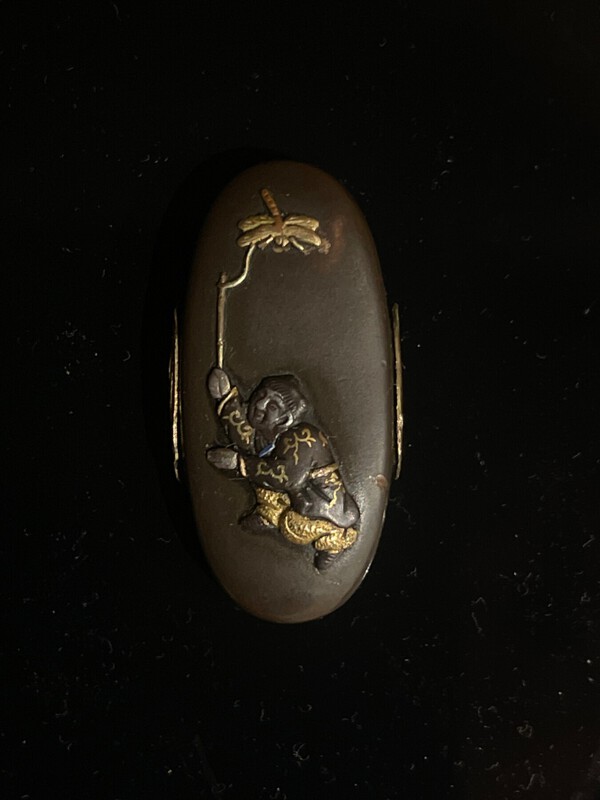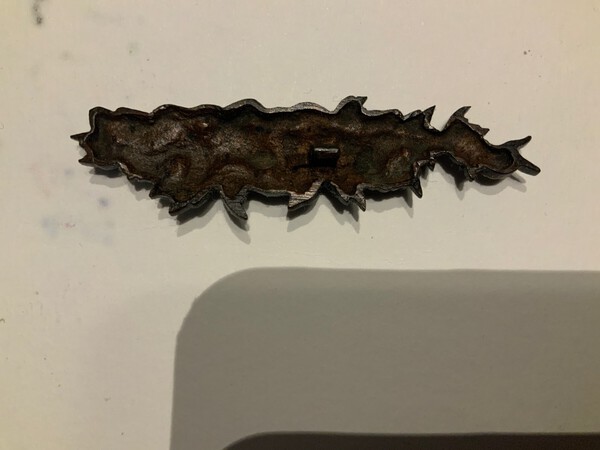
Jack Zacao
Members-
Posts
36 -
Joined
-
Last visited
Content Type
Profiles
Forums
Events
Store
Downloads
Gallery
Everything posted by Jack Zacao
-
Many high end Tsuba have word ‘應需’ meaning by order by the signature
-
Love when this happens- need signature confirmation help for menuki
Jack Zacao replied to Mantis dude's topic in Tosogu
Thank you Bugyotsuji, I get it now. Congrat to Ken for figuring that out. I found the artist name in a book below. But, the quality of the signature on the menuki seems worse than the reference by a bit. you would have to judge the quality of the carving on the front to see if it lives up to the name of this known artist. Anyway, enjoyed your research so far! -
Hello, Here is a set of Fuchi and Kashira with Chinese boys catching butterfly and dragonfly . I think it is Mito school but would like to hear your opinion. also i am interested to know why Japanese like to depict chinese boys (唐童) in the designs.
- 1 reply
-
- 1
-

-
Love when this happens- need signature confirmation help for menuki
Jack Zacao replied to Mantis dude's topic in Tosogu
i still think it is a Kao, until you find the character to convince me. -
Love when this happens- need signature confirmation help for menuki
Jack Zacao replied to Mantis dude's topic in Tosogu
The first one is ‘秀‘ second not known, does not look like any Chinese character to me, maybe a Kao -
Extra large single Menuki, school and where to mount
Jack Zacao replied to Jack Zacao's topic in Tosogu
just to follow up with my old post, i found this menuki pair online that is a near identical to mine. It is so similar that they may be mass produced at some point or made with a mold / stamp and only chiseled with details in the surface … is that a plausible theory ? anyone knows these kind of practices in ancient Japan? link is shown below https://www.carters.com.au/index.cfm/item/1704437-two-large-menuki-edo-period-1603-1868-in-felt-lined-presentation/ -
Just found a near identical one in an auction. It is used as a lid for a netsuke. I doubt that is the original use of the part also. https://www.liveauctioneers.com/item/176152037_fine-Japanese-kagamibuta-netsuke
-
Hi, I wonder if anyone can tell whether the following decorative parts are Menuki or pouch clasps? The thin plates suggest latter but the mess of solder seems to be later modification. My guess is they are works in Meiji period but rather high quality. The inlays of lips and teeth are so fine and vivid I can not tell what materials are used. Size 1.8 cm across, 5 grams total. Thanks.
-
The authenticity of the tsuba «Soshishi Nyudo Soten sei»
Jack Zacao replied to Exclus1ve's topic in Tosogu
It is a variation of the character 道, in the name 入道宗典, it is a quick way of handwriting. The two signature are the same character by character -
Shibuichi Fuchi & kashira Inlaid in iroe takazogan
Jack Zacao replied to Exclus1ve's topic in Tosogu
Hi Jake, The picture you found is the great unno shomin, who is the famous nephew of the artist who made this set: https://ja.m.wikipedia.org/wiki/海野勝珉 This maker of this set is the Frist Generation master not the one with the same name in Meiji era, who is the second generation(who indeed made the tsuba you found) I found this in the description of my first link provided above : 慶應◆特別保存刀装具 水戸金工【初代海野美盛】秀逸作 四分一磨地 肉合彫 象嵌色絵「樊會図」縁頭 初代 means the first generation again, i make this call based on the Kao being exactly the same -
I am relatively new to the hobby and you guys must have seen lot more in this design. Thank you for providing the new directions to look into.
-
Shibuichi Fuchi & kashira Inlaid in iroe takazogan
Jack Zacao replied to Exclus1ve's topic in Tosogu
The scheme seems like a lion dance. Here is a similar example on a tsuba https://art.thewalters.org/object/51.105/ -
Shibuichi Fuchi & kashira Inlaid in iroe takazogan
Jack Zacao replied to Exclus1ve's topic in Tosogu
Found a similar one from the same artist . Note the Same Kao https://aucview.com/yahoo/m464146272/ -
Shibuichi Fuchi & kashira Inlaid in iroe takazogan
Jack Zacao replied to Exclus1ve's topic in Tosogu
Great work! There are two famous artists named 美盛,repectively 海野美盛 (初代 first generation master, also called 海野太三郎) and 海野美盛二代(second master) This is most likely from the former because he lived in late edo period whereas the second master lived in Meiji period. The first master is the uncle of the great 海野勝珉 or Unno Shomin, who is regarded as one of the best metal artists in Meiji period. I can not be certain but I can not find any other who is named 美盛 . I just realized you already know the maker, above is what I wrote before reading the link you provided -
I think it is Shakudo or shibuichi with gold gilding, although the gold is not applied very carefully which is not uncommon. Is it really a common practice to apply lacquer on sword fittings?
-
Thank you Jake and Soshin for your comments and opinions. What I really like about it is the mountain and lake scene it depicts. It is a well known pattern in Chinese porcelain and scholar paintings and we can see the influence of culture here. But this pattern is very rarely used in swords fittings primarily due to the space limitations I suspect. Later in the Meiji period, it becomes very popular again on export mixed metal display objects, which are larger in size. The size is only the same as a US nickel coin and the amount of details shown is pretty amazing. The pictures do not do justice and the pair shows much better in hand. So far I found a couple examples from the same name but they are kozuka and Fuchi, links are shown bellow. I will continue to look for the answer and that is what makes collecting fun. https://www.winners-...productDetail/15888/ https://art.thewalters.org/object/51.1086/
-
This is a pair of round Menuki with high quality carving and true inlay, of 2.1 cm diameter. They do not have poles so are just glued on the handle I guess. The signature are of Hamano school 浜野 but only the last two characters 寿隨 are carved. There were three craftsman used signature 浜野寿隨 based on my research but I can not tell which one made this. Has anyone here seen other stuff with same signature in same style? I know the chance is remote but maybe I am lucky.thanks
-
Unfortunately I don’t know the Japanese pronunciation but you can ask some AI and it shouldn’t be hard. I did look the name up in some books but did not find a match.
-
My Translation “XX 亭 亮歲 kao“ the first two characters have worn out and are unrecognizable
-
Thank you both for the comments and suggestions. The plate of my Menuki is not much thicker than Soshin’s because mine are smaller , less than 4 cm in length. They are about 5 grams in total. The crispness of the lines and chisel marks suggest they are not casted, not to this quality. I will try to improve my photo quality in future posts.
-
Thank you Soshin for your comments. I only suspected it was old because of the open work. I heard from somewhere that more open work means older in period. Not sure how much truth to that. I know the Goto school uses thick plate but less open work, i guess thinner plate is better for open work designs otherwise hard to work with … your welcome to post yours to compare. Thanks again.
-
-
Hi, I wonder if anyone can help identify the school and/age of this pair of Menuki. They look very old style, I suspect they are before edo or early edo era. Any comments would be greatly appreciated.
-
I assume this is the guy, but I do not really understand the description, you need to use AI to translate it.
-
Extra large single Menuki, school and where to mount
Jack Zacao replied to Jack Zacao's topic in Tosogu

















